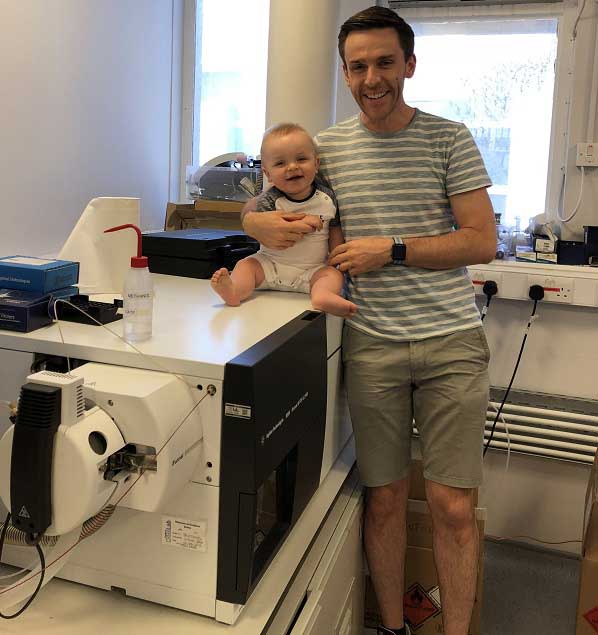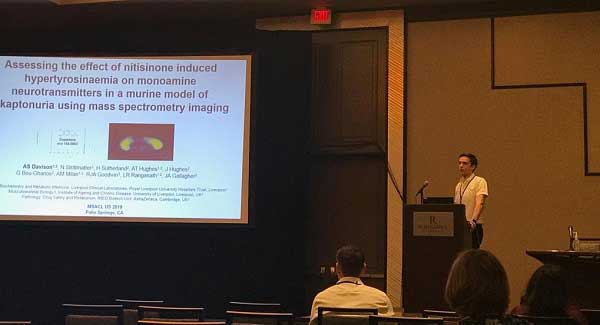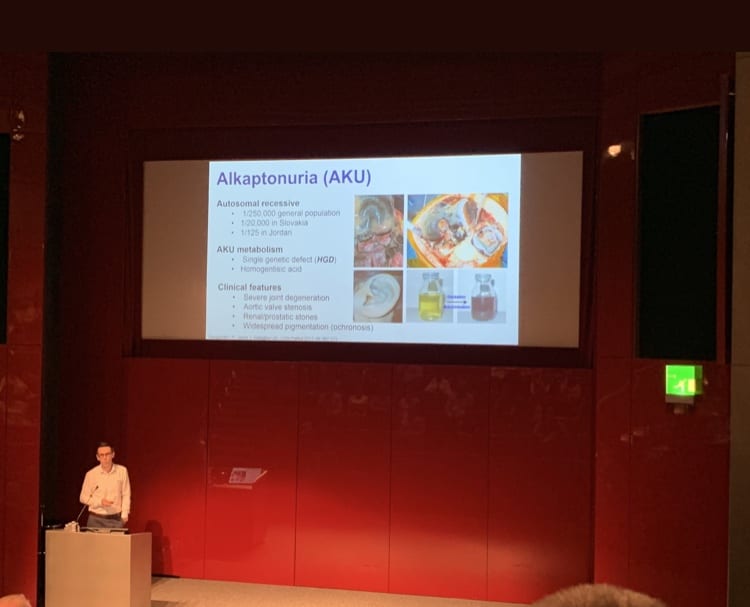Todays blog is written by Dr Andrew Davidson who has recently completed his PhD in AKU and nitisinone.
I became a state registered Clinical Scientist in Clinical Biochemistry back in 2008 and following this, like all professionals in the speciality I studied for my fellowship examinations for the Royal College of Pathologists. After obtaining this in 2012, I was looking for a new challenge! Around this time Professor Ranganath at the Royal Liverpool University Hospital had received a large European FP7 grant for the DevelopAKUre clinical trials and the Robert Gregory National AKU Centre (NAC) was opening. I had always wanted to do a PhD and had a keen interest in metabolism and mass spectrometry.
I spoke with Professor Ranganath about any opportunities he was aware of and whether he could support them. The challenge in my position was that I was in a full-time NHS post, so I had to apply for funding. I looked into this and eventually made an application for funding to the National Institute for Health Research (NIHR) for their Doctoral training programme. After completing a rather large application and attending a national interview, I was successful and started a part-time PhD at the University of Liverpool under the supervision of Professors Ranganath and Gallagher in March 2015.

My son and I in lab and the mass spectrometer I mainly used for my PhD work
There were two main objectives to the research I carried out during my PhD. The first was to establish a method to assess changes in metabolism in patients with AKU following treatment with nitisinone. This is because very little was known about the wider impact of nitisinone treatment at the time. A better understanding of this is important for the safe use of the drug. The second aim was more specific and focused on whether the elevated tyrosine that is seen after treatment with nitisinone alters the metabolism of the neurotransmitters dopamine and serotonin, and whether this is associated with altered mood/depression.
After five years of research, I submitted my PhD in January 2020 and was awarded my PhD recently after a successful defence in my viva. Presented in my thesis is a lot of hard work; a method was established to assess changes in metabolism observed in patients with AKU following treatment with nitisinone. Novel insights into the wider metabolic consequences of treatment with nitisinone were shown from the analysis of (i) blood and urine samples from AKU patients and (ii) urine, blood, cerebrospinal fluid (CSF) and brain tissue from an AKU mouse model that we have at the University of Liverpool.
Importantly the work in my thesis also addresses uncertainty around the impact of the elevated tyrosine that is observed following treatment with nitisinone and its impact on neurotransmitter metabolism. Experiments confirmed that only peripheral metabolism of neurotransmitters occurs and that this, and the elevated tyrosine observed following treatment with nitisinone are not associated with altered mood/depression.

British Museum, July 2019
The work presented in my thesis is a unique example of where studying metabolism can help understand the metabolic consequences of treating a disease. It is hoped that my work will provide a platform for future clinical metabolomic studies into AKU and other complex metabolic diseases.
I am very grateful to have had the opportunity to carry out this research, which was only made possible through collaborative working between patients, scientists and clinicians, and funding from the NIHR.

MSACL US Palm Springs 2019
Published works included in my PhD
Davison AS, Hughes AT, Milan AM, Sireau N, Gallagher JA, Ranganath LR. Alkaptonuria – many questions answered, further challenges beckon [Review]. Ann Clin Biochem 2020;57(2):106–120
Davison AS*, Norman BP*, Ross GA, Hughes AT, Khedr M, Milan AM, et al. Evaluation of the serum metabolome of patients with Alkaptonuria before and after two years of treatment with nitisinone using LC-QTOF-MS. JIMD Rep 2019;48:67–74 *Joint first authors
Davison AS*, Strittmatter N*, Sutherland H, Hughes AT , Hughes J, Bou-Gharios G et al. Assessing the effect of nitisinone induced hypertyrosinaemia on monoamine neurotransmitters in brain tissue from a murine model of alkaptonuria using mass spectrometry imaging. Metabolomics 2019;15(68):1-10 *Joint first authors
Norman BP*, Davison AS*, Ross GA, Milan AM, Hughes AT, Sutherland H et al. A comprehensive LCQTOF-MS metabolic phenotyping strategy: application to alkaptonuria. Clin Chem 2019;65(4):530-539 *Joint first authors
Davison AS, Harrold JA, Hughes G, Norman BP, Devine J, Usher J et al. Clinical and biochemical assessment of depressive symptoms in patients with Alkaptonuria before and after two years of treatment with nitisinone. Mol Genet Metab 2018;125(1-2):135-143
Davison AS, Norman BP, Smith E, Devine J, Usher J, Hughes AT et al. Serum amino acid profiling in patients with Alkaptonuria before and after treatment with nitisinone. JIMD Rep 2018;41:109-117.
Davison AS, Norman B, Milan AM, Hughes AT, Khedr M, Rovensky J et al. Assessment of the effect of once daily nitisinone therapy on 24-h urinary metadrenalines and 5-hydroxyindole acetic acid excretion in patients with alkaptonuria after 4 weeks of treatment. JIMD Rep 2018;41:1-10
Davison AS, Milan AM, Gallagher JA, Ranganath LR. Acute Fatal Metabolic Complications in Alkaptonuria [Review]. J Inherit Metab Dis 2016;39(2):203-210
